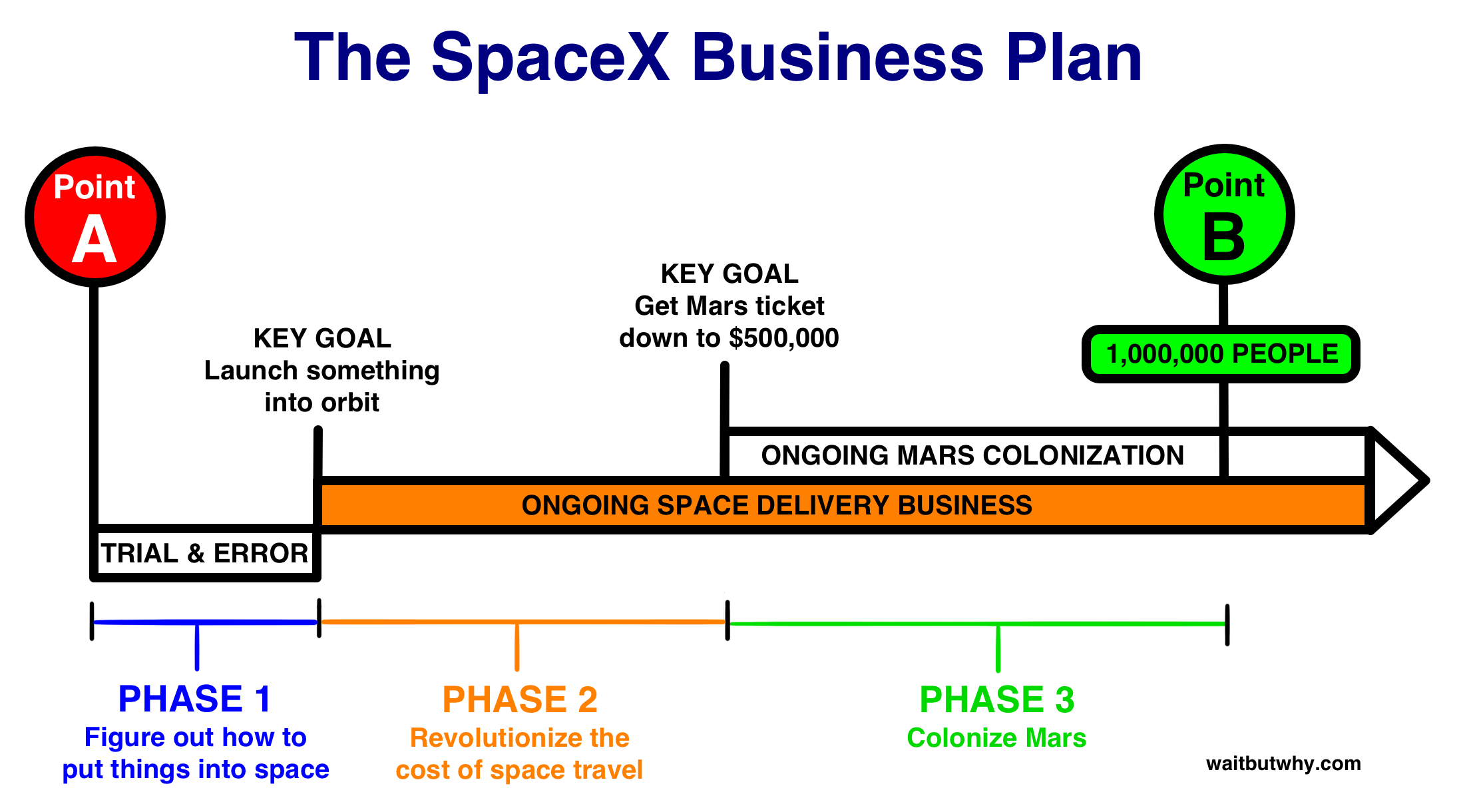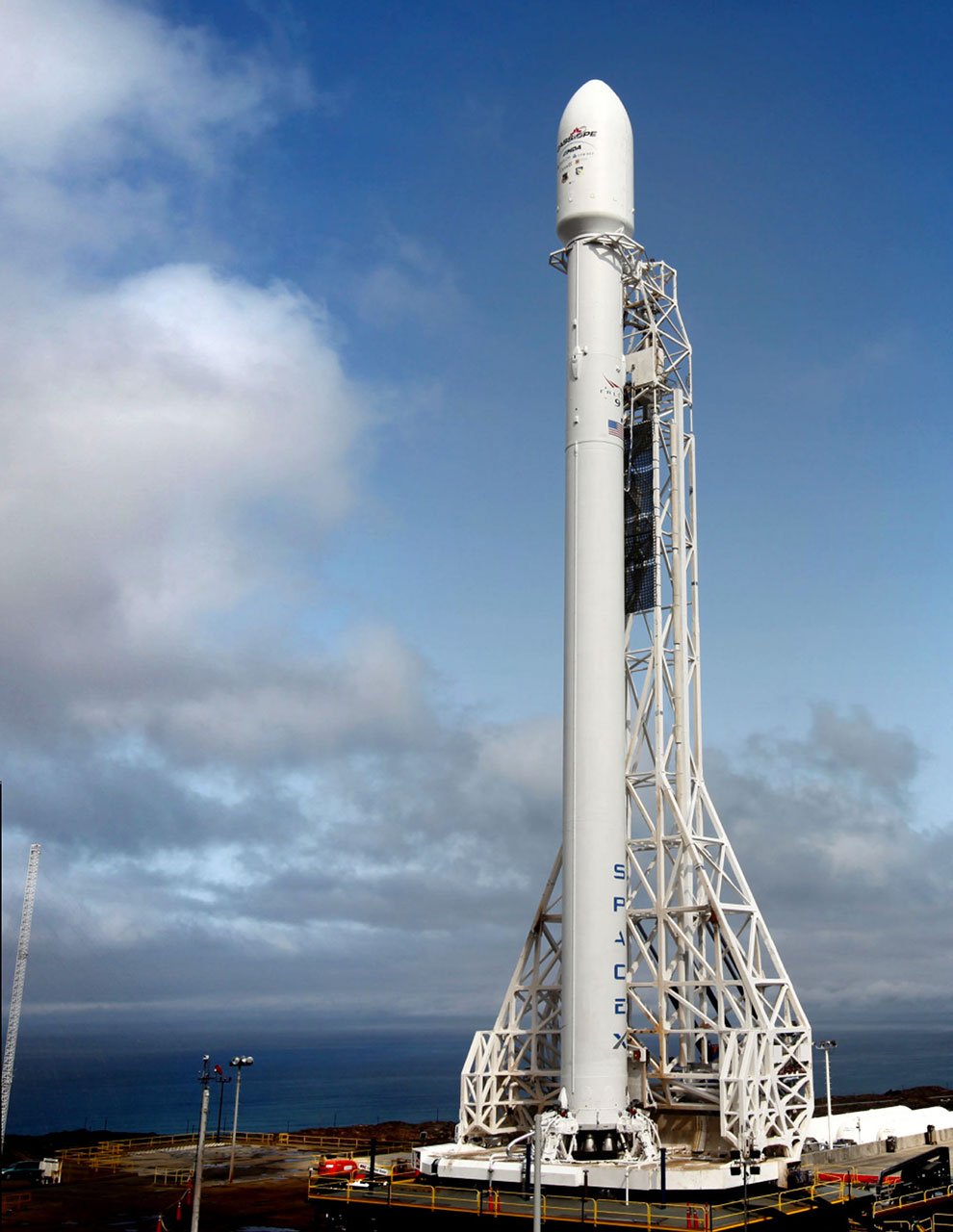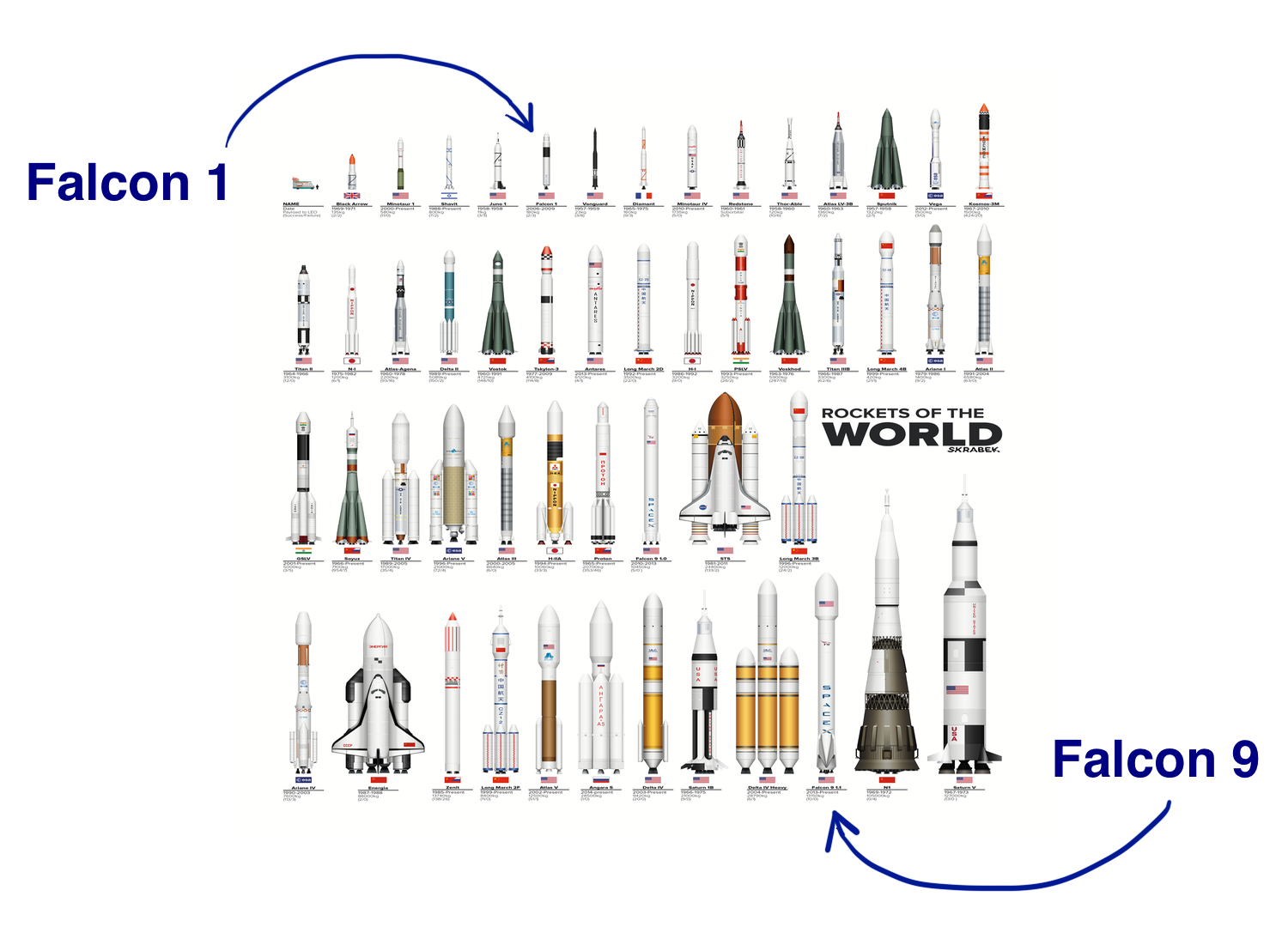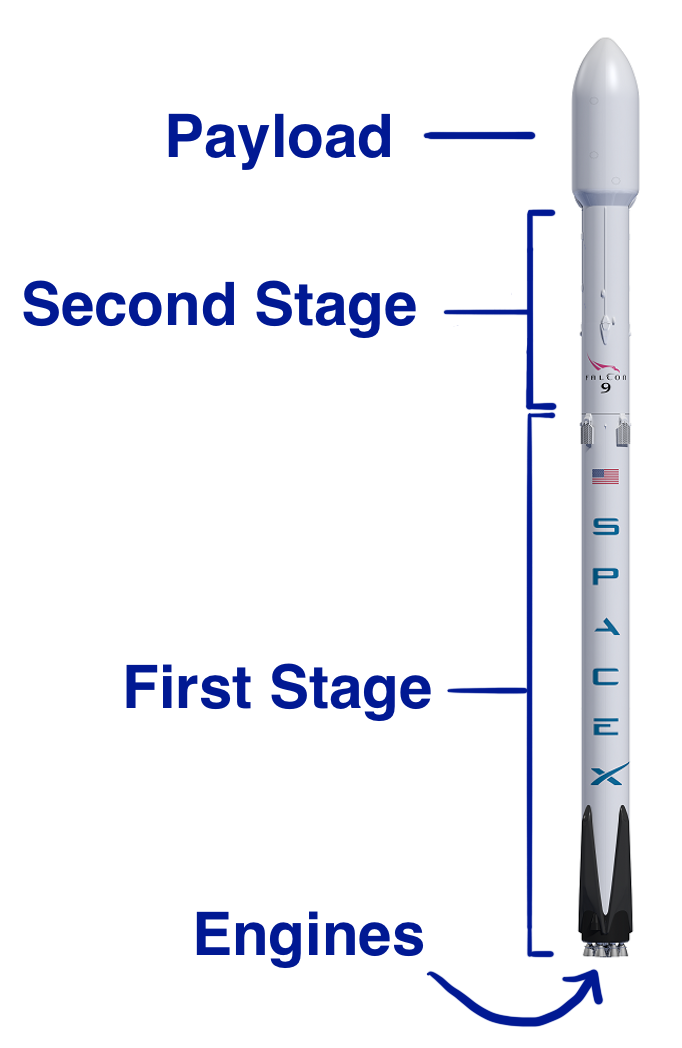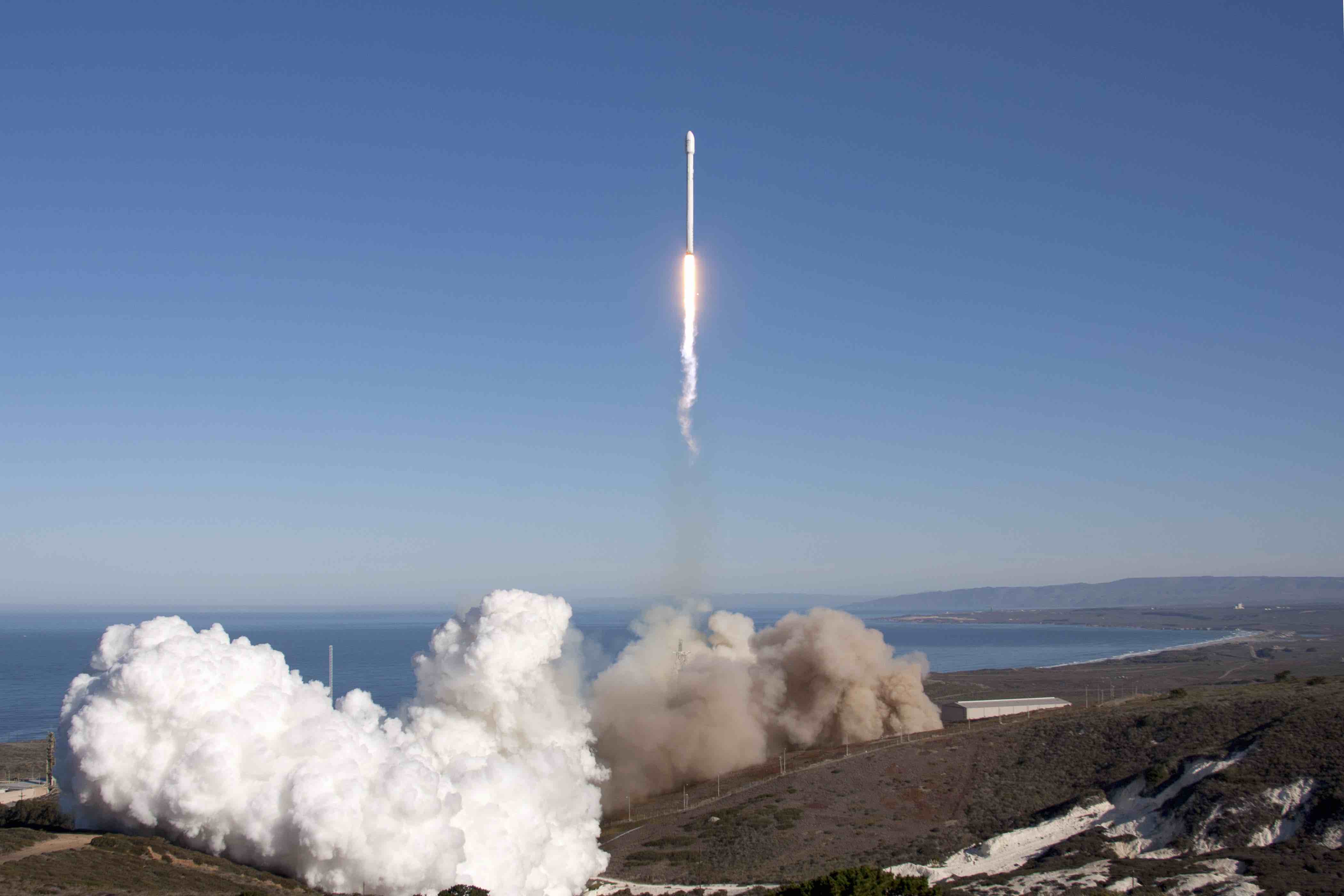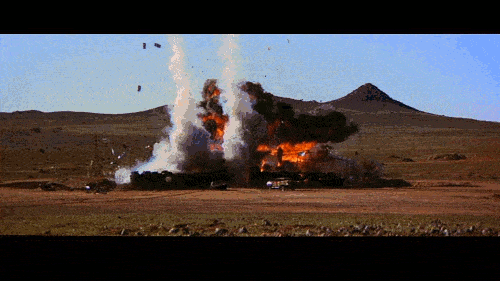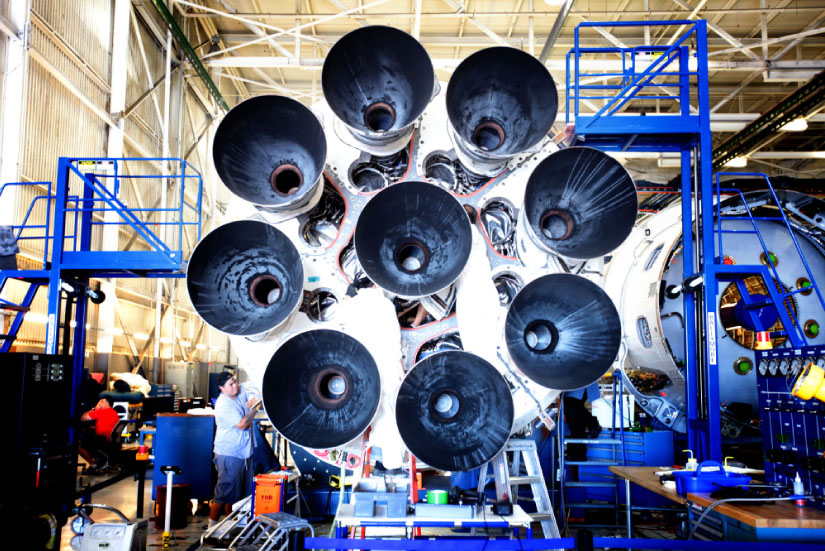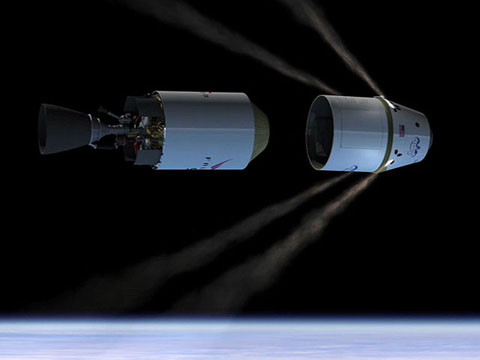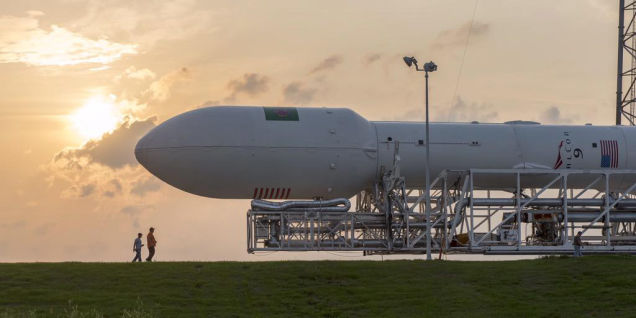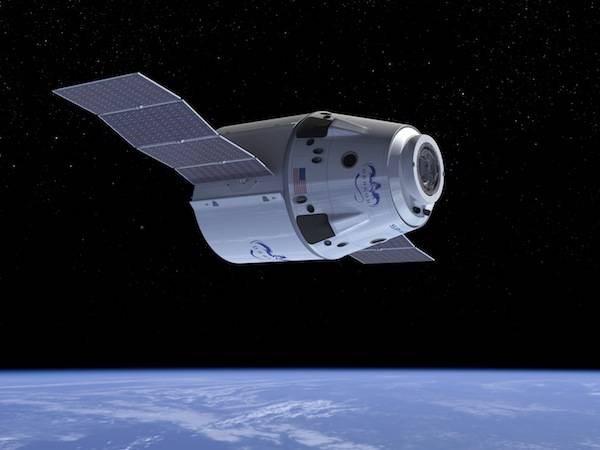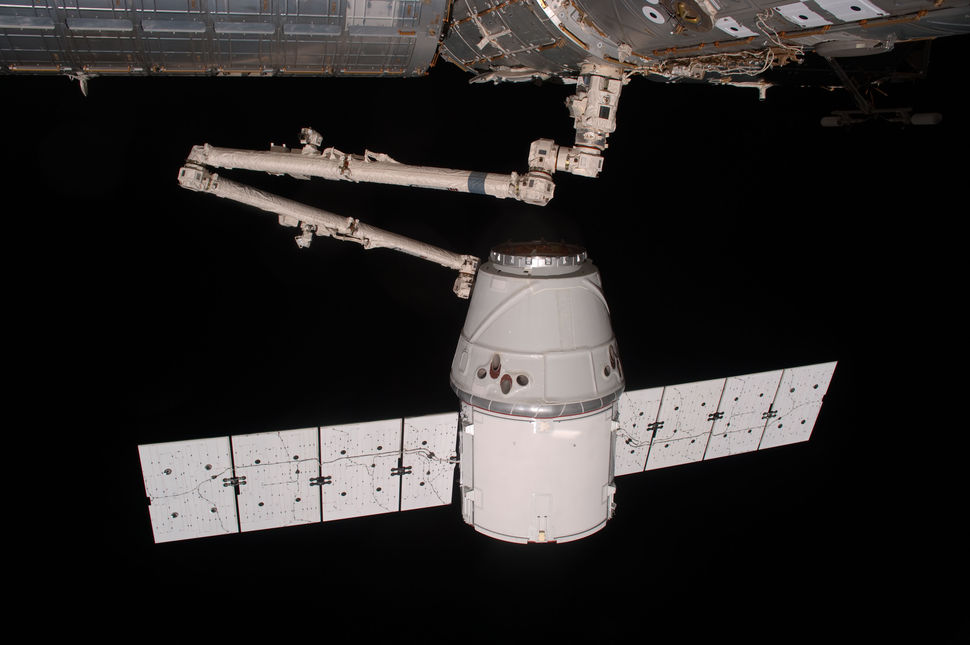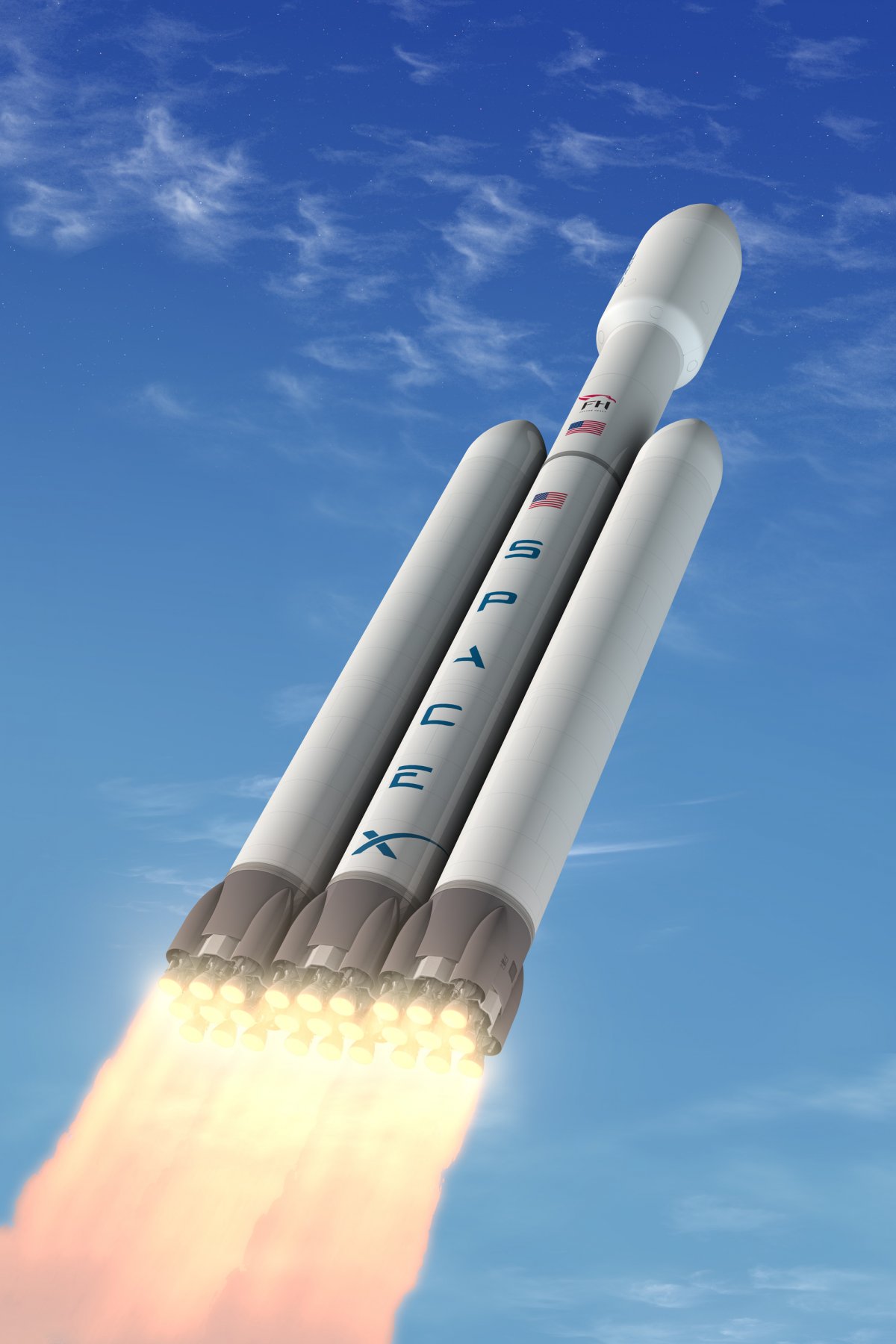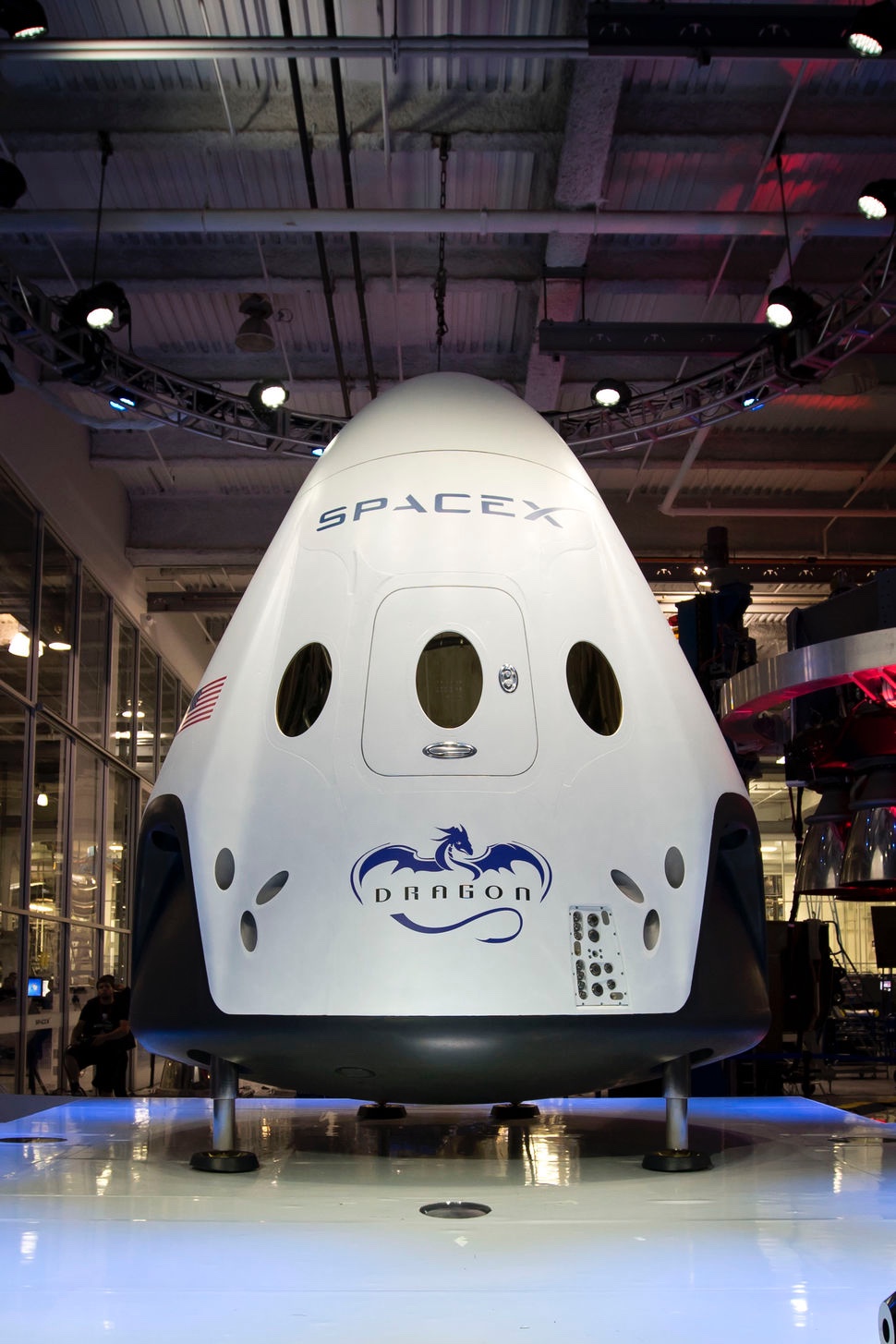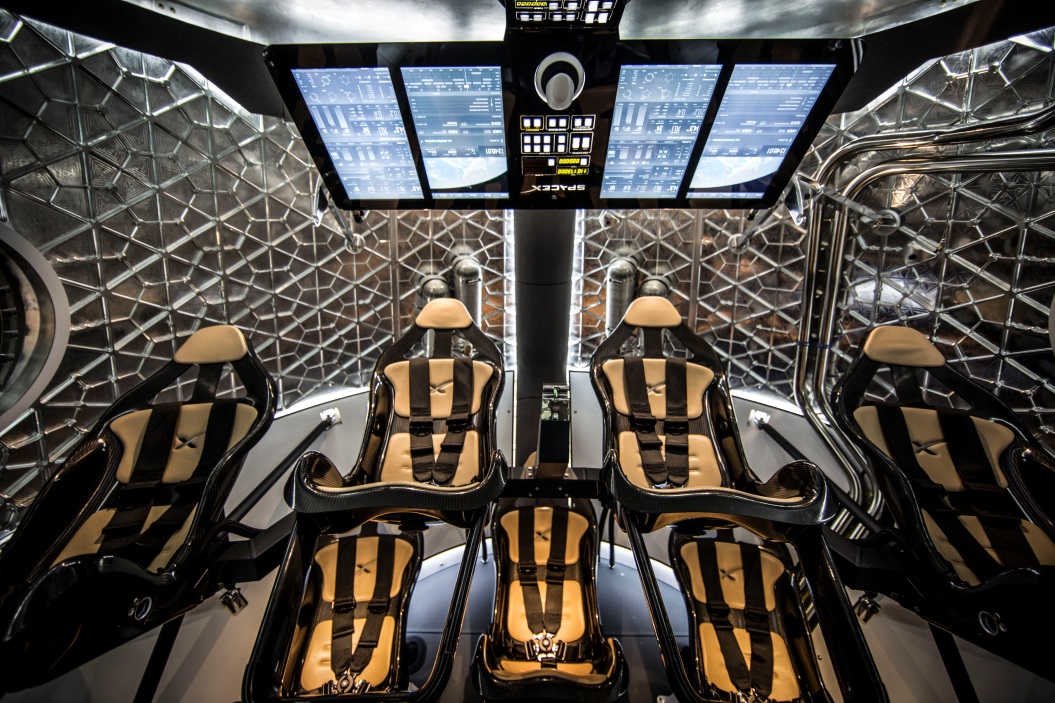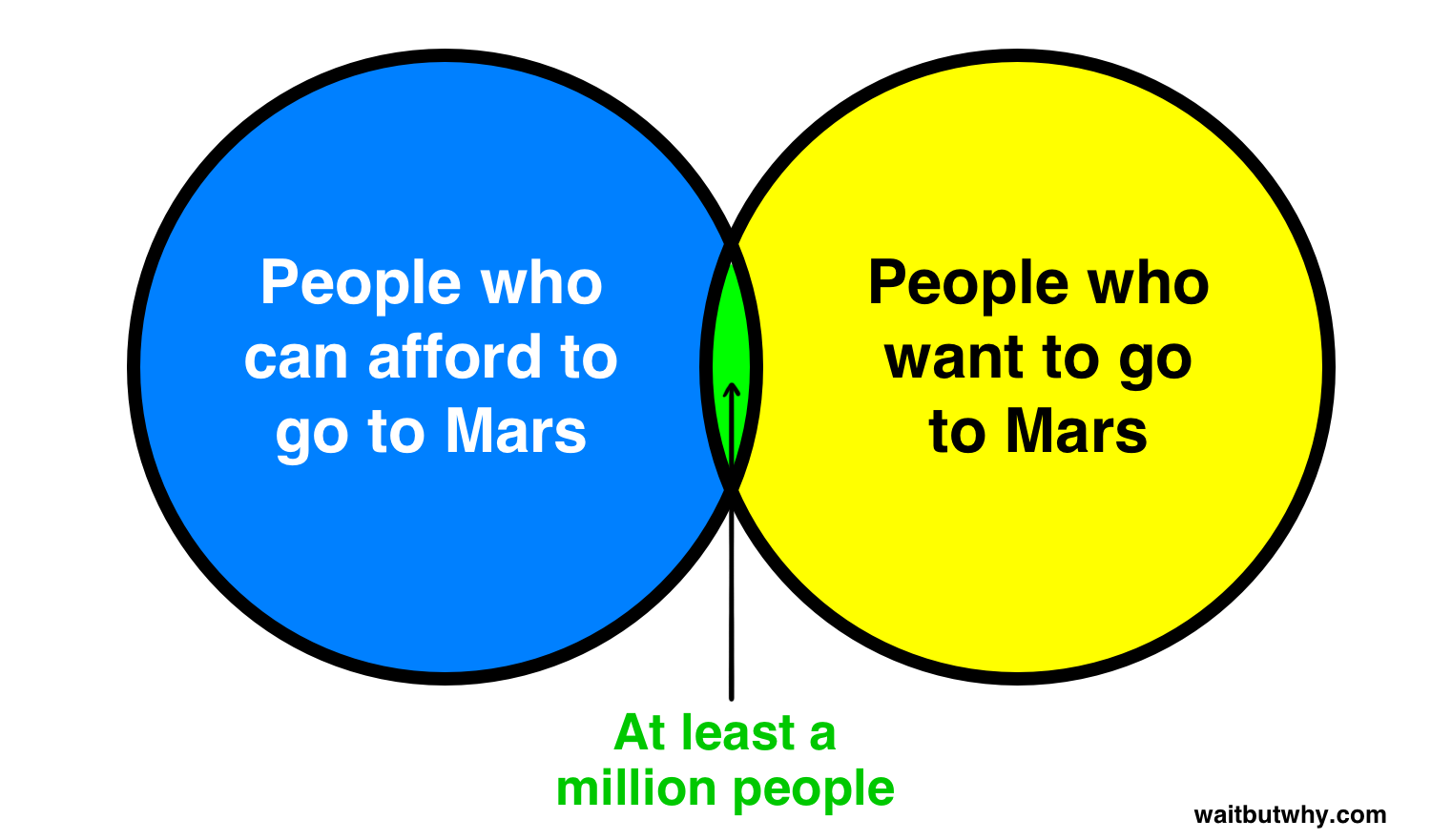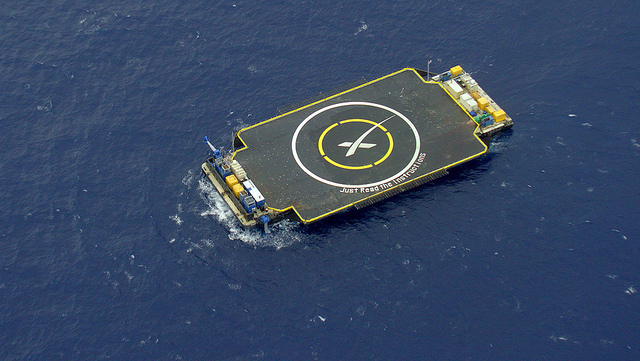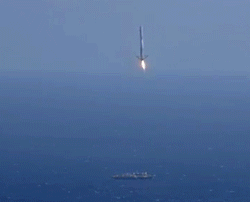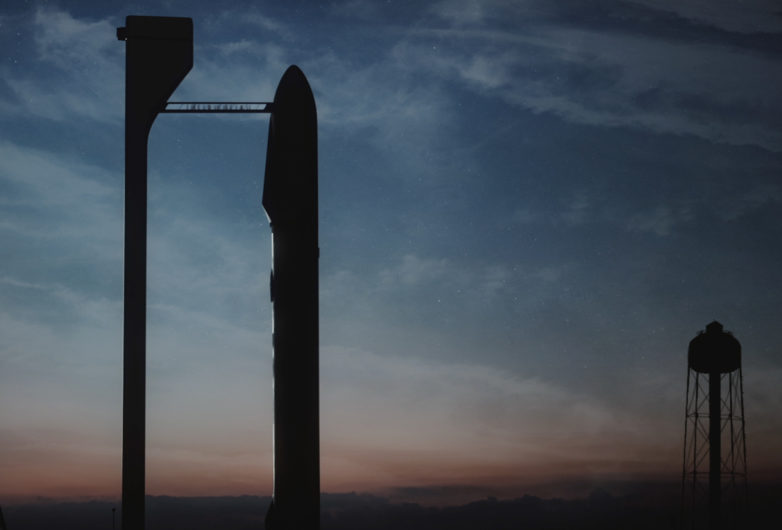Phase 2: Revolutionize the cost of space travel
Main Characters: Falcon 9, Dragon, Falcon Heavy
Goal: Get the price for a trip to Mars down to $500,000/seat
Today, many people have heard of SpaceX. Few know what SpaceX does. And even fewer know what SpaceX really does.
Here’s what SpaceX does: It takes things to space for people, for money.
And as we established, here’s what SpaceX really does: It’s an innovation machine, trying to solve one big problem—the astronomical cost of space travel—because that’s the key to making humanity a space-faring civilization that can become multi-planetary and back itself up on other hard drives. It supports itself by taking things to space for people, for money.
We’ll get to the really does part later. First, let’s look at what it means to take things to space for people, for money.
Falcon 9
In 2008, with a successful orbital launch achieved and a slew of new customers eager to sign up for SpaceX’s weirdly cheap space delivery service, it was time for SpaceX to take off the training wheels and build themselves a Harley. Meet Falcon 9:1
Let’s just go ahead and get it out of the way right now—Falcon 9 is the world’s largest dick-shaped sculpture. It’s something every SpaceX employee has learned to endure, an unmentionable fact that hovers over their professional lives, and it’s something we’re all going to live with as well.
That issue aside, Falcon 9 is the world’s most advanced rocket and a huge upgrade over Falcon 1. Falcon 9 is huge—at 224 feet (68 m) tall, it’s over three times the height of Falcon 1 and the height of a 20-story building. On its side, it would stretch 3/4 the way across a football field. And while Falcon 1 could bring less than one ton of payload to orbit, Falcon 9 can carry 13 tons. In every way, Falcon 9 puts SpaceX in the ring with the big boys.2
Learning about rockets will make you respect the shit out of rockets. A rocket has to be unbelievably rugged—it’s a 1,000-ton object filled with explosive material that soars at blazing speeds through hurricane-force winds—but also meticulously designed down to the millimeter because it’s full of very un-rugged things like computer circuit boards, delicate satellites, and living people. Normal manufacturing techniques don’t always cut it for an object so particular—in the SpaceX factory, I was shown bizarre-shaped Falcon 9 parts that had to be 3D printed (and 3D designed) because there was no other good method to make them just the right way.1
But since none of that is our problem, let’s ignore all the details and oversimplify:3
The First Stage
The first stage has a very important three-minute job—blast the second stage and the attached payload up to an altitude of about 100km before peacing out and falling into the ocean.4
The first stage, like almost all parts of Falcon 9, is manufactured in SpaceX’s California headquarters (here’s a fast-motion video of the manufacture process).
Most of the first stage is a big fuel tank with two key parts: a huge tank of rocket-grade kerosene next to a huge tank of liquid oxygen. It doesn’t work on a rocket to draw oxygen from the air because, among other reasons, the rocket quickly gets too high up for there to be much oxygen around. So it has to bring the oxygen with it. Oxygen becomes a liquid at -297.3 F (-183 C), and once it does, it’s around 1,000 times more dense than gaseous oxygen—so you can pack a lot of it. These two ingredients are mixed together into explosive propellant.
How Rocket Engines Work
It might seem odd that the guy who’s super not into burning fossil fuels with his car company would choose to blow through hundreds of tons of it during every launch with his rocket company. The problem is that rockets have to burn fuel—Musk has even said he thinks all transportation will eventually go electric, except rockets.
The reason is Newton’s Third Law: Every action has an equal and opposite reaction.
Newton’s third law is why a deflating balloon will move in the opposite direction that it’s shooting air out, why a gun jolts backward when it shoots, and why this incompetent man’s canoe goes away from the dock when he runs toward it:5
When you think about propelling a vehicle, think about this same idea.
One way to make a vehicle move is with a propeller. Propellers work by pushing air in one direction, which pushes the propeller and whatever’s attached to it in the other direction—kind of like standing a foot away from a wall and pushing the wall with your hand—which forces your body away from the wall. The problem is that in space, there’s no air for the propeller to push against, so trying to use a propeller there is like standing in a room far away from the wall and pushing your hand out toward nothing like a weirdo, which wouldn’t push you backward at all. Even in the upper atmosphere, where there’s still some air, if the air is too thin it’s like trying to get a big pushback by pushing your arm into a hanging curtain—it won’t work well.
On the other hand, if you deflated a balloon in space, the balloon would shoot backward—in the same way it would on Earth—because the force in that situation isn’t created by pushing on air outside the balloon (like a propeller), it’s created by the air pressure being much higher inside the balloon than outside of it and the air being forced out of the balloon by the pressure difference. In fact, if you were floating around in the middle of space and had an air-filled balloon, you could move yourself a bit by deflating the balloon in the opposite direction—and for those few seconds while the balloon was deflating, the balloon would be an engine.
The engines at the bottom of Falcon 9 are just more powerful deflating balloons. A fiery explosion creates extremely high temperature and pressure, which makes the exploding gas want to rapidly expand into the lower-pressure space all around it. And if something blows up in the middle of an empty field, it can expand outward in all directions but down:6
A rocket engine creates an explosion that wants to do the same thing—but the engine, like the balloon, won’t let the force move outward in any direction except one. And being “rejected” from all the other directions just adds to the force:7
So that’s why rocket engines work in a vacuum. They don’t need anything external, like air, to push down on—by expelling a mass of hot gas, they’re essentially pushing down on that.
Musk would love to have a better way than exploding fuel to power rockets, but he’s not sure we’ll ever find one. I asked him about it, and he said, “For rockets to go electric, there would have to be a few Nobel Prizes awarded.”
The Merlin
Falcon 1’s ascent was entirely propelled by one ragingly powerful SpaceX-invented engine, called the Merlin.8
Merlins are rad. One Merlin engine has a thrust of over 73 tons—i.e. it can lift 73 tons of weight—which means if you stacked 40 cars on top of the engine in that picture, it could lift the whole stack into space in about three minutes. It’s one of the most2 efficient, advanced engines in the world. An important statistic in the rocket engine world is thrust-to-weight ratio—i.e. how many times its own weight it can lift. Weighing about a half ton and peaking at over an 80-ton thrust, the Merlin’s ratio is 165:1, which blows away all other engines like it. Here’s a Merlin test firing:
How intense is that shit.3
Now imagine nine of them firing together. That’s what happens during each Falcon 9 launch—the rocket’s name comes from the nine engines, which are arranged in an “octaweb”:9
Together, the nine Merlins generate 650 tons of thrust, enough to shoot a stack of 360 cars into space (a stack that would be the height of One World Trade Center), and they burn through a combined 540 gallons (2,044 L) of fuel every second—enough to drain a swimming pool in less than a minute. Most of what the engines end up lifting is the rocket and its fuel, which weigh in at a combined 550 tons, but there’s still plenty of leftover muscle to add a sizable payload on top.
The Second Stage
Three minutes after launching, the first and second stages separate:10
The first stage falls back to Earth, and it’s now the second stage’s big moment to shine. The second stage is just a mini version of the first stage, and it’s also mostly filled with fuel. But instead of nine Merlin engines, the second stage only has one—a special version made to be used in the vacuum of space, with a bell extension to increase its thrust. Fewer engines are needed here because A) no more thick atmosphere, B) it’s lifting a lot less weight without the first stage attached, and C) it’s already going really fast so much of the work is done.
The second stage’s job can be over in a few minutes or last multiple hours. Its engine can go off and on, and it has directional maneuverability. Its job is to be precise and get the payload to the exact right location and velocity. Once it does that, it separates from the payload and drops off:11
Speaking of payload, there are two ways the top of a Falcon 9 can look, and the difference is which type of payload it’s bringing with it. Here’s the first way:12
When it looks like this, it’s usually carrying a satellite. The bulge at the top is a two-piece protective clamshell thing called a fairing. It tends to look about the size of a bathtub, but it’s actually the size of a school bus:13
Once the second stage gets going at a certain speed (about four times the speed of a bullet), the fairing’s two halves separate and fall back into the atmosphere to burn up.14
The second way the top of a Falcon 9 can look is this:15
The more triangle-looking top means the rocket is carrying a Dragon spacecraft.
Dragon16
SUV-sized Dragon is SpaceX’s spacecraft, made for transporting cargo, and one day people, to and from space. NASA’s big 2008 contract with SpaceX was for 12 Dragon missions to the ISS. In the picture above, the cone-shaped thing on the right half is the Dragon’s pressurized capsule and the only thing that returns to Earth. The cylindrical part on the left is an unpressurized trunk, which can carry additional cargo and holds the solar panels (which is what gives Dragon power in space). Together, the two can hold around six tons of cargo.
Those little holes on the side are mini thruster engines Dragon uses to maneuver in space, and on its bottom is a heat shield for re-entry.
Falcon 9 starts its career
As all of this new equipment was in development, Falcon 1 made its fifth and final launch in the summer of 2009, launching a satellite for the Malaysian government—SpaceX’s first paying customer, and successful launch #2. But with the taller and more handsome Falcon 9 in the womb, Falcon 1 wouldn’t be needed anymore, and it was retired.
Falcon 1 had made its five launches from a tiny Pacific island called Kwajalein Atoll. But having joined the big boys club with Falcon 9, SpaceX took out leases at America’s prime time launch pads—Vandenberg Air Force Base in California (for launches to the south) and legendary Cape Canaveral in Florida (for launches to the east).
And in the summer of 2010, the first Falcon 9 headed off for the launch pad, causing thousands of highway-drivers to say, “What the hell is that?”17
Its inaugural voyage—a demo run—was a success.
Then, SpaceX started doing things commercial companies aren’t supposed to know how to do.
Sending a spacecraft out to space is hard—but bringing it back might be even harder. You know how if you jump into the ocean off of a dock, nothing bad happens (except the water being probably freezing because everyone likes to pretend that immersing yourself in cold water is an okay activity)—but if you jump into the ocean off of a bridge, you die? With the only difference being your body’s velocity when it hits the water? Same situation with the Earth’s atmosphere.
You don’t feel the atmosphere right now because of your minimal velocity, but open your hand and vigorously move your arm back and forth like a psycho and you can feel the atmosphere. Speed yourself up even more by riding in a convertible or a fast-moving boat and you’re quickly pummeled in the face by the atmosphere. But the speed isn’t just about you. It’s about your speed relative to the speed of the atmosphere. Putting your hand out the window in a car going 50 mph feels the same as putting your hand out the window of a parked car with 50 mph winds outside. So when an object in orbit—which we established earlier has to be traveling at about 17,000 mph (27,300 km/h)—decides it’s over it and tries to come back to Earth, it experiences the equivalent of a 17,000 mph hurricane. Our official hurricane “levels” go from category 1 (74-95 mph) to category 5 (which starts at 155 mph), going up a level roughly for every 20 mph increase in wind speeds. At ground level, moving 17,000 mph would be like hanging out in a category 842 hurricane. The force of a category 842 hurricane would be lower in the thin atmosphere at the high altitudes where objects first enter—but still.
What scares us about hurricanes is their force. But in a category [three-digit number] hurricane, you have much bigger problems. The spacecraft’s blistering speed in the upper atmosphere means the air in front of an incoming capsule doesn’t have time to “get out of the way” and becomes super-compressed and blazingly hot. Lower, where the atmosphere is thicker, the spacecraft has to handle the heat of the intense atmospheric drag. Rocks can’t handle it—which is why they turn into shooting stars—and building a spacecraft that can requires a lot of fancy technology.
Up until 2010, only five governments had ever managed to get a spacecraft out into space and recover it successfully. Falcon 9’s second launch pinged the first Dragon into orbit on a demo run for the new spacecraft, and after two orbits, Dragon came barreling through a category 842 hurricane and still existed on the other side, making SpaceX the first company, and sixth entity of any kind, to recover an orbiting spacecraft. Not bad for a company on their seventh launch.
Falcon 9’s third launch made history again, when on a demo mission for NASA, Dragon became the first commercial spacecraft to attach to the ISS.418
SpaceX made a little triumphant video with the highlights.
Falcon 9 was the real deal. Vance writes, “Where the Falcon 1 blasting off from Kwajalein was the work of a start-up, the Falcon 9 taking off from Vandenberg is the work of an aerospace superpower.”19 And with two of three planned demo missions done, NASA had seen enough to scratch the third demo mission and get started with the official resupply missions to the ISS on Dragon.
If you’re curious what a launch is actually like, here’s a video of mission CRS-6, an ISS resupply mission that launched out of Cape Canaveral on April 14, 2015:
Things to note:
- The plumes of white smoke coming out of the rocket before launch is oxygen from the liquid oxygen tank in the rocket as some of it escapes as gas.
- About five seconds before liftoff, a deluge system called “Niagara” starts flooding the launch site with water. The purpose of this is to muffle the deafening sound of the engines, because otherwise, the sound waves would be so powerful that they’d actually damage the rocket.
- The engines start firing a couple seconds before liftoff. What’s happening is that huge clamps are holding the rocket down as the engines fire so a computer can quickly test them to make sure they’re all working. If they are, the clamps release at T-0 and the rocket takes off.
- Timing is critical down to the second. Even one second off schedule will mess up the rendezvous with the ISS.
- Launches are hectic.
- Over the first three minutes, the bright orange stream of delicious fire coming out of the rocket becomes increasingly spread out, icky-looking, and gray. This is because as the altitude increases, atmospheric oxygen thins out, and combustion has a harder and harder time taking place outside the rocket.
- The first stage separates at 3:26.
- After stage separation, the big black bell you’re looking at is the second stage’s sole Merlin engine. You can’t see any fire coming out of the engine because combustion is impossible at that altitude so it immediately stops after leaving the engine.
- Nothing much happens for the next seven minutes.
- At 11:09, the rocket is sufficiently in orbit and the second stage separates.
- Most of the rest of the video is a view of the now on-its-own Dragon taken by a camera on the second stage.
- In the last 25 seconds of the video, you can see the Dragon’s solar panels unfold.
After five Falcon 1 launches and three Falcon 9 launches, most of which were tests and demos, SpaceX was ready to start its space delivery service. Falcon 9’s fourth launch and the first official ISS resupply mission was the first in a string of 15 straight successful deliveries (six Dragon missions for NASA, nine satellite missions for other customers), bringing us to May of 2015, when I wrote this sentence and accidentally jinxed the whole company:
Since their first three failed launches, SpaceX has launched 20 times—all successes.
And after that 20th straight success, Musk tweeted, “Rocket launch good, satellite in geo transfer orbit. Still so damn intense. Looking fwd to it feeling normal one day.”
Then—on the very next launch—this happened:20
A launch failure is a horrible thing, even when no people are involved. It’s why SpaceX VP Mark Juncosa told me that each launch day is constant, torturous anxiety. It seems kind of like a pitcher throwing a pitch with two outs in the ninth inning of game 7 of the World Series, except the ball takes a few months to get to the plate, and they have to watch the moment when it finally gets to the batter on TV.
But devastating failures are part of what you sign up for when you get into the space game. After the demoralizing third failure of Falcon 1, Musk wrote to his employees, “It is perhaps worth noting that those launch companies that succeeded also took their lumps along the way. A friend of mine wrote to remind me that only 5 of the first 9 Pegasus launches succeeded; 3 of 5 for Ariane; 9 of 20 for Atlas; 9 of 21 for Soyuz; and 9 of 18 for Proton. SpaceX is in this for the long haul and, come hell or high water, we are going to make this work.” This puts SpaceX’s June 2015 failure in perspective and lets it serve more as a reminder of how impressive its 20 for 24 start has been.
The good news about failures is they show you exactly where your weak points are. In this failure, the culprit was a single two-foot long, one-inch thick steel bar—one of hundreds in the rocket—that was supposed to handle five tons of force and snapped after only one. From now on, SpaceX will individually test every steel bar that goes into a rocket. You can see Dragon slip away unscathed (at the top of the screen, toward the beginning), and if it had software to deploy its parachutes earlier than planned, the contents in it would have survived. From now on, Dragon will have that software.
And that brings us to today.
In an industry full of middleman price hikes and decades-old equipment, SpaceX’s tightly controlled in-house supply chain and cutting edge technology has made it the world’s cheapest option for space delivery. For years, the US government has relied on two major aerospace companies—Boeing and Lockheed Martin, along with their joint venture, United Launch Alliance (ULA)—for domestic launches. ULA charges the government—and the US taxpayers—$380 million per launch. For a similar launch, the US government only pays SpaceX $133 million. For launches with other customers, without all of NASA’s special requirements, SpaceX charges $60 million per launch.
Given the unbelievable bargain, SpaceX unsurprisingly has a long line of customers vying for their services—they currently have a backlog of over 50 planned launches, worth over $5 billion. They’re doing everything they can to ramp up production, aiming to soon make 40 Falcon 9s a year. Musk believes that within a few years, SpaceX will cost less than a tenth of the industry average, and he believes SpaceX can take over the majority of the world’s commercial launches.
This is a big deal for the US, not just SpaceX.
The US, through Boeing, is proud to be one of two major airplane producers (with Europe’s Airbus being the other), but for some reason, the country has allowed itself to become an insignificant part of the global launch industry—while Europe, Russia, and China dominate. The main provider of US launches, ULA, gets most of its business from the US government, and gets the most expensive part of its hardware equipment—the engines—by buying them from Russia. SpaceX is making the US a big player in the launch industry again as business increasingly pours in from all around the world—and they manufacture almost everything domestically.
More Angry Giants
While SpaceX might be a terrific development for both Americans and the future of space travel, not everyone is so pleased about their arrival on the scene.
Remember last post when we took a deep look into what’s going on under the hood of the auto and oil/gas industries, and it turns out it’s all pretty messed up and humanity is kind of being taken for a ride without realizing it? Because that’s what happens when opaque industries have a “special” relationship with the government and barriers to entry that keep out competition from underdogs? And how Tesla is kind of exposing all of that and forcing a fat, happy, and docile industry to innovate, and how they all desperately wish Musk would disappear?
I could almost just copy and paste that section into this post as well.
The space launch industry is like a handful of auto mechanics in a small town that all charge about ten times as much as they need to, but because A) customers are clueless about the process and what it should cost, and B) all the competition overcharges as well, there’s no incentive to upgrade equipment, increase efficiency, and bring down costs. SpaceX is like a newcomer to town who sets up an auto shop, comes up with newer, better ways to fix cars, works harder than anyone else, and is able to charge a fraction of the price for the same service. Which ruins everything for the town’s other auto mechanics.
In 2014, Europe’s Arianespace—a major player in the global launch industry—asked European governments for additional subsidies to handle competition from SpaceX. A Falcon 9 trip to GTO (the highest satellite orbit) now costs $15 million less than a launch on China’s historically-cheap Long March rocket. As for the other major player in the launch market, Musk has said, “My family fears that the Russians will assassinate me.”21
All around the world, launch customers are noticing what SpaceX is doing, then looking at their own launch company and asking, “Wait why am I paying so much?”
When I asked Musk about all the industries that want to drop a piano on his head, he said, “It’s a roomful of toes—it’s hard to avoid stepping on them.” And of all the toes SpaceX is currently stepping on, it’s stepping the hardest on ULA.
ULA is a Dick Blue Box
ULA, the Boeing and Lockheed joint venture, charges more than anyone for a space launch. But it doesn’t matter what they charge. ULA doesn’t have to compete with the rest of the world’s launch market—because ULA gets a constant flow of automatic business from the US military. Here’s how it works:
1) The US military needs to launch a lot of things into space, so there’s plenty of business.
2) Because military equipment is tied to national security, the US wants the launches done by an American company.
3) Because space launching, like auto repair, is an opaque process to the public and to politicians, no one knows that ULA’s launch price tag is much higher than it needs to be.
4) ULA works with the government on a “cost plus basis,” meaning their payment for a launch is a percentage of whatever the launch costs them—i.e. they’re incentivized to make it cost more, not less.
5) There’s ample money to go around because of the US’s astronomical military budget.
6) Most infuriatingly, many of the decision-makers in the US Department of Defense are friends with the leadership of ULA, and ULA is a common place for DoD officials to work when they retire from government. So ULA is more likely to get a nod and a wink from the DoD than an audit into how they spend their money.
What that all adds up to is at best, a flawed system that puts zero pressure on lowering costs and at worst, a grand-scale government scandal—all paid for by the US taxpayer.
And do you know what a ULA-DoD circle jerk really doesn’t want around? A company like SpaceX. SpaceX had succeeded in winning much of NASA’s business, but in order to be awarded a military launch contract, a company needs special certification, and curiously, SpaceX had a very hard time becoming certified. Calling bullshit on the process, and knowing that the law requires there to be fair competition for the military’s launching needs, in 2014 Musk brought the issue to Congress, making the case that “SpaceX is not seeking to be awarded contracts for these launches. We are simply seeking the right to compete.”22
But he received a lot of pushback. Despite clear evidence that ULA charges six times SpaceX’s rate per pound of payload, politicians like Senator Richard Shelby of Alabama (one of whose biggest donors is the aerospace industry23) argued that it was a national security issue—an odd line of argument, considering that ULA pours money into Russia, buying their engines and other parts, while SpaceX does all of their business in the US. In an interview a few months ago, Musk vented about the situation: “ULA has decided that they’re afraid even of an unfair competition. They don’t want a fair competition. They don’t even want an unfair competition. They want no competition at all…they’re afraid that we’ll take some of the huge gravy train they have exclusive access to, or that it’s not going to be as big.”
SpaceX has made some progress in the last year and has been awarded a small number of military launches, but only a tiny fraction—this is a battle SpaceX will be fighting for a while. I asked Musk about the difficulty of competing against ULA. His response: “These are not pushovers, it’s the military-industrial complex. You know in movies, how they do terrible things? Well yeah, those guys.”
The SpaceX revenue model will be growing and expanding in the coming years. Here are three of the coolest things in the pipeline:
1) Falcon Heavy
Remember how I made a whole big deal about putting nine Merlins together and being able to lift a skyscraper-high stack of 360 cars? Falcon Heavy is a Falcon 9 except instead of having one first stage, it has three.24
With 27 Merlins, the Falcon Heavy engine platform can lift about 2,000 tons, or a mile-high, 1,100-car stack. Launching for the first time in 2016, Falcon Heavy will be able to take more than double the payload of any other rocket in the world—and do so at the lowest price per pound of payload in history (ULA charges three times what Falcon Heavy will charge per launch and will take less than half the payload). Here’s a little payload comparison of the industry’s most heavy-duty rockets:
2) Quadrupling the number of satellites in orbit
Actually though. A couple months ago, Musk announced that SpaceX would be starting a satellite-production operation in Seattle that would put 4,000 internet satellites in Low Earth Orbit by 2030—three times the 1,300 total satellites that are in orbit today. His reasons:
- Bring costs down to bring technology up. Today, it typically costs about a quarter billion dollars to make a satellite and around the same amount to put it in space. That makes every satellite launch super high stakes, which makes companies risk-averse, so they tend to use older, proven technology and make sure to get at least 15 or more years of usage out of each one. The result is that a lot of the satellites performing services for us today were made in 1990, with 25-year-old technology. SpaceX wants to figure out how to make satellites for a much lower cost, and combined with their ability to launch much more cheaply, they’ll be able to put cutting-edge satellites in orbit, do so frequently, and replace them just as frequently.
- Bring internet to anyone, anywhere. I sat down with Rajeev Badyal, SpaceX’s VP of Avionics Engineering, who is in charge of the satellite project. He explained that SpaceX’s constellation of 4,000 solar-powered satellites will work together intelligently to cover every part of the Earth and beam lightning-fast internet to places where it’s badly needed. He talked about how really only a few places on Earth (Europe, the US, parts of India and East Asia, etc.) are truly blanketed with good internet, and how this would be a game-changer for many other parts of the world, especially the most remote. All you’d need to make it work is a small, pizza-box shaped receiver, which could be put anywhere outside, and you could have fast internet on the North Pole, the middle of the Pacific Ocean, the top of Mount Everest—anywhere. He also talked about other ways the satellites could be used—you could attach cameras to them to use for crime reports, live Google Maps, weather—anything.
- Even more angry giants. Wouldn’t Time Warner Cable and Comcast be a great addition to the pile of big, low-quality, monopoly-like companies Musk is finding a way to compete with? In his announcement, Musk mentioned it: “In cases where people are stuck with Time Warner or Comcast, this would provide an opportunity to leave.” (This got a huge cheer from the crowd.)
- It’s lucrative. Between selling satellites it manufactures and creating revenue off of those it puts in orbit, SpaceX can make a ton of money from this.
- Solves the Mars internet problem. Physical cables are the way of the past and Mars will be a planet of the future. Musk plans to have SpaceX-manufactured internet satellites circling Mars down the road, bringing fast internet to the future Mars colony.
3) Manned Space Travel
In 2014, the US and Russia got mad at each other, as they are wont to do—this time over Russia deciding that it would actually be super cool if Crimea were part of Russia—and the US responded by imposing sanctions against Russia’s space program. To which the Russian Deputy Prime Minister tweeted:
After reviewing the sanctions against our space industry, I suggest that the United States deliver their astronauts to the ISS using a trampoline.
Well played.
This is what happens when your once mighty space program becomes so lame that it can’t launch its own astronauts into space anymore. You have to rely on countries you might get mad at, which puts you in a terrible position.
The only other country that can launch people into space is China, and the US is even madder at them—so mad that Chinese astronauts are prohibited from hanging out at the cool kids’ club on the ISS. It’s like a town with three rival mob bosses, but awkwardly, only two of them have a car, so the third needs to get a ride to work with one of the others. Not ideal for the third boss.
Elon Musk chimed in with his own tweet soon after:
Sounds like this might be a good time to unveil the new Dragon Mk 2 spaceship that @SpaceX has been working on w @NASA. No trampoline needed
— Elon Musk (@elonmusk) April 29, 2014
The Space Shuttle program retired in 2011, starting this window we’re in where the US has no way to perform manned space flight. The next Space Shuttle-style full US space program is supposed to be the creatively-named Space Launch System and its Orion spacecraft, but delays have pushed the program’s commencement back to at least 2021. The US doesn’t want to rely on Russia until 2021, so in the meantime, NASA held a contest to choose private contractors to use for crewed launches. NASA ended up splitting up the $6.8 billion contract between Boeing (who would get $4.2 billion) and SpaceX (who would get $2.6 billion).525
In May of 2014, SpaceX unveiled the second iteration of Dragon—Dragon 2.26
The first Dragon is cool—it’s one of the only spacecraft that can return to Earth intact, and it’s currently the world’s only operational spacecraft that can bring cargo back from the ISS.6 But Dragon 2 is much cooler.
Dragon 2 can dock with the ISS without being pulled in by the ISS’s arm like an infant.
Dragon 2 has seats inside and fancy touch screens (most of today’s spacecraft were designed in the 60s and still have buttons and knobs like an old radio):27
But the coolest thing about Dragon 2 are its engines. The spacecraft has eight super-powerful little engines, called SuperDracos, each of which could lift four cars. SuperDracos are so specifically designed that they’re entirely manufactured by 3D printing, the first rocket engines to be made that way. I’m going to embed another engine-firing video, because it’s so fun to watch. Here’s a SuperDraco being tested:
Dragon 2’s SuperDracos have three main purposes:
1) Maneuvering in space
2) Propulsive landing – more on this in the next section
3) To abort the astronauts if something goes wrong
The third is a critical feature for crew safety. Even the best rockets sometimes fail, often in catastrophic fashion—as SpaceX just demonstrated for us—and Dragon 2’s abort system allows the spacecraft to get the hell away from the scene before the bomb goes off. If the two Space Shuttle disasters had had this feature, the astronauts might have been saved. Here’s a recent test showing Dragon 2’s abort system in action, which for some reason struck me as kind of adorable:
The power of the abort is hard to fully grasp in that video. The eight SuperDracos are so powerful that they take the Dragon more than the length of a football field in two seconds, and over a third of a mile (about half a km) in just over five seconds. And while other manned capsules have had abort capabilities before, the others have only been able to abort during launch—Dragon 2’s abort system works all the way up to orbit.
Musk also wants to redefine what it means to be an astronaut, explaining that a person shouldn’t have to be an astronaut to fly in space. His vision has ordinary people hopping on top of a SpaceX rocket and going to space with relatively little training or skills—the same way we fly in planes today (kind of reminds me of how at one point, only a computer scientist could use a computer, and how outdated that concept seems today). Following the theme of acknowledging that it’s 2015, not 1965, SpaceX is also redoing the concept of the spacesuit—Musk has specifically insisted they be cool looking and ditch the Marshmallow Man style.
The timetable has the first SpaceX and Boeing manned flights launching in 2017—but there’s currently a push in the US Senate to slash NASA’s funding, which would delay things by at least two years. Nahhh.
So that’s what SpaceX does and how it makes money. The delivery service is doing its job—SpaceX is profitable and should have a long runway ahead to stay afloat. A recent investment by Google and Fidelity valued the company at $12 billion.
But Musk has said that his nightmare would be for SpaceX to end up in the hands of someone who will milk it for short-term profit. Because as we laid out at the beginning of this Phase 2 section, everything we just discussed is what SpaceX does—but not what SpaceX really does.
What SpaceX really does has been happening ever since the development of Falcon 1 and is evidenced by the unbelievable deal you can currently get to deliver something to space on a Falcon 9 versus any other way.
But SpaceX’s low prices would still be classified as an incremental improvement—not a transformative game-changer.
What SpaceX is really doing is something much, much bigger—they’re working on an innovation so groundbreaking that if they can pull it off, they’ll reduce the cost of launching a rocket by 100 times more and completely alter humanity’s future in space—and make a multi-planetary future possible.
Changing the Game
Remember this whole thing from before?
Musk estimates that $500,000 for a ticket to Mars might be the magic number that makes the blue circle big enough that the green zone reaches a million people. The way he describes it, with a $500,000 ticket, it would be like buying a middle-class home in California, and “most people in advanced countries, in their mid-forties or something like that, could put together enough money to make the trip.”28
So how close are we? In 1989, when Bush Sr. proposed an initiative to bring US astronauts to Mars, NASA estimated it would cost $450 billion. To send 4-6 astronauts. About $100 billion per seat.29
Close. Just 200,000 times Musk’s per-seat goal of $500,000.
In 2004, Bush Jr. entertained the idea of sending Americans to Mars. NASA said it would cost $50 billion. $10 billion a seat. Still 20,000 times too high.
So how the hell do you bring the price of anything down 20,000 times.
Musk’s plan is to attack the problem from two angles.
1) Bring lots of people
The Falcon rocket family is SpaceX’s moneymaker, but neither Falcon nor Dragon will ever take people to Mars.
For one, Dragon is the size of an SUV—going to Mars takes three months at the very least. Not a good plan.
Secondly, if you’re gonna go all the way to Mars, you should make it a big carpool.
That’s why SpaceX has a long term plan to build a rocket that will make Falcon 9 look like a hot dog—
The Mars Colonial Transporter.
The MCT rocket will be a giant, powered by a much more powerful SpaceX engine, called the Raptor, that’s currently in the works—and its spacecraft will be able to hold at least 100 people.
So right there, if SpaceX can do that, they’ve cut the current cost-per-seat estimates by at least 20.
Now we’re down to this being 1,000 times too expensive.
But there’s another thing—SpaceX has, through its Falcon innovations, already reduced the cost of a launch to one-fifth of the industry standard, and Musk believes it’ll be down to a tenth of the industry standard in the coming years. Since the Bush Jr. figure was assuming industry standard costs, that brings things down to only 100 times too expensive.
A bigger spacecraft can help lower the per-seat cost of going to Mars, but it doesn’t change anything for today’s commercial launch industry, it doesn’t get us anywhere close to cheap enough to bring large numbers of people to Mars, and it doesn’t solve what Musk calls “the fundamental problem with space exploration.”
So what is this big game-changing innovation I keep hyping up but not telling you about?
2) Reusability
Imagine the current air travel industry with one key difference: an airplane works for one flight only. Each flight is on a brand new plane, and after the flight, passengers exit into the terminal and the plane is broken down into scrap metal and possibly-reusable parts that are sent off to be refurbished for use in a future plane.
An airplane costs around $300 million to build. So in this new model, in addition to paying for the crew’s time and fuel, airlines have to spend $300 million extra each flight to build a plane. How would that change things?
First, there would be very few flights available—the schedule would be limited by the pace of plane production. Second, the price of a round-trip ticket between Chicago and San Francisco would now cost about $1.5 million per person. For economy.
Air Force One would still exist. Wealthy countries would have a small military air fleet. A few governments would fly in order to perform certain types of science experiments. People with 10 billion dollars would probably fly a decent amount, but people with only one billion dollars couldn’t really afford it. And you? You would be born, live your life, and die without ever riding on a plane.
If this were the situation, people would probably look at the non-existent air travel industry and determine that clearly, there was no public will to travel by air. Politicians would argue against putting much government funding into the exorbitant activity. Most people wouldn’t even fully understand how airplanes worked, and they wouldn’t waste any time imagining what the world would be like if everyone could use them. It would become a non-topic. We’d travel by car and railroad and ship and that would be that.
Can you see where I’m going with this?
No one in history—not the US, not the Soviets, and certainly not the stagnant fat cats at ULA—has figured out how to make rockets reusable. Rockets spend months getting built, head up to space, and either burn up in the atmosphere or crash into the ocean as scrap metal. It’s not that no one has tried—the US and Soviets have both put tens of billions of dollars into the problem—it’s that no one has figured it out.
The Space Shuttle system was supposedly “reusable.” But there are three parts of a Space Shuttle—the spacecraft, which was genuinely reusable, the rockets, which were technically reusable but took nine months of refurbishment that nullified the cost benefits, and the big orange gas tank, which was totally unreusable and converted to immediate trash after the launch. So it was 1 for 3, and as a result, Space Shuttle missions cost a laughable $1.6 billion apiece (over $200 million per astronaut).
A bigger spacecraft, coupled with SpaceX’s cost-saving innovations, has theoretically brought things to within two orders of magnitude of the goal—$50 million per person. And that cost assumes a new MCT would have to be built for every flight.
The first game for SpaceX was figuring out how to launch something into orbit. Now they’re onto a new, much harder game—reusability. If SpaceX can create what they call “a fully and rapidly reusable rocket system”—leaving the only launch costs as fuel, maintenance, and interior support systems, just like an airplane—it’ll reduce the cost of space travel by a factor of 100. Maybe more.
So how do you do it?
First, you need a better way to land. Musk describes the three ways a rocket and spacecraft can land:
Landing Type 1 (most basic): Parachuting into the ocean
This is how almost all spacecraft land today, if they land at all.
Problems: Parachutes don’t work in places with no air, like the moon; landing in corrosive salt-water heavily damages the equipment; it’s undignified (imagine an alien trying to be intimidating by landing in our ocean with parachutes and having to swim to shore).
Landing Type 2 (intermediate): Wings and wheels onto a runway
This is how the Space Shuttle landed.
Problems: Wings don’t work in places with no air, like the moon,7 or no runways, like everywhere besides Earth; while this method can be used for a spacecraft, it’s much harder to do with the rocket—and full reusability means landing both the spacecraft and the rocket stages.
Landing Type 3 (advanced): Propulsive landing
Propulsive landing means coming down the same way rockets take off. This is how the Apollo Lunar Modules (like Apollo 11’s “Eagle”) landed on the moon.
Propulsive landing allows you to land a rocket or spacecraft neatly on a landing platform, with minimal damage to the vehicle.
It’s easier to envision a spacecraft doing a propulsive landing than a rocket doing one, because we’ve seen spacecraft do it before. Dragon 2 is being designed to be a landing specialist—those same SuperDraco engines Dragon 2 uses to abort in an emergency will also be used to land, and Dragon will be able to land on any type of surface of any solid body in the Solar System as easily as a helicopter can land on Earth. Landing a rocket that way is a more foreign concept, and much more difficult.
Here’s SpaceX’s vision for Falcon and Dragon reusability—worth the watch:
If it works, the idea is that a rocket and spacecraft could land, be refueled, and head back up within hours. Again—just like an airplane.
Juncosa explained to me that the first and most important step is to learn how to land just the Falcon’s first stage. It’s the most important because the first stage costs about as much to build as a jumbo jet and makes up the bulk of the rocket’s total cost (especially the engines)—if they succeed at that, it’ll be a giant step forward. And they’ll show the world, including the currently-very-skeptical aerospace industry, that reusability is indeed possible. They’ll have drawn a blueprint for how other rocket-makers can slash their own costs—and begun a new era in space travel.
This is how landing the first stage is supposed go (click for a larger view):30
When it says “burn,” it means that a single main engine fires (the one in the middle). Since weight is such a factor during launches (there’s almost no room for added weight or the rocket won’t be able to get a payload into orbit), the rocket will have enough fuel for exactly three burns. The first is used to stop the rocket’s ballistic path (i.e. the normal arc it’s naturally on) and direct it toward the landing site.8 The second is used to slow down—from 3,000 mph to 550 mph (885 km/h)—so it doesn’t burn up in the atmosphere. The third is used right above the landing platform, to slow it down to 5 mph (8 km/h).
Since weather is moving and unpredictable, there’s a lot of software in the rocket sensing outside forces and adjusting the trajectory. The rocket has little wing flaps called “grid fins” that open up and steer the rocket (the grid fins and landing legs also slow down the rocket, cutting the terminal velocity in half). Grid fins work when you’re in the atmosphere, but up in space where there’s no air, grid fins are useless, so the rocket steers with ejections from “cold gas thrusters”—little nitrogen jets that come out of the rocket.
If all works according to plan, about nine minutes after launch, the rocket will land on this floating platform in the ocean, 200 miles out from the launch pad:931
This is hard. If you scale down all the sizes, it’s like firing a pencil over the top of a skyscraper and trying to land it on a shoe box on the ground—on a windy day. SpaceX likens the challenge of controlling the descent through the atmosphere to “trying to balance a rubber broomstick on your hand in the middle of a wind storm.” Popular Mechanics calls it “a tense juggling act, where any one of thousands of moving parts can push the entire system into mayhem. If the rocket does land softly on the barge, it’s because millions of insanely detailed self-adjustments have kept the Falcon 9’s composure as it dove through chaos.”
To hone its skills, SpaceX created a first stage rocket they call Grasshopper. In 2012, they were able to launch Grasshopper to the height of a 12-story building, pause it there for a few seconds, and then bring it back down to the pad:
Over the next two years, they launched Grasshopper higher and higher until finally launching a real Falcon 9 first stage a kilometer in the air and returning it to the platform.
Finally, it was time to try it for real—on an actual launch. In January of 2015, SpaceX performed a routine launch and brought the first stage through the atmosphere and tried to land it. Here’s what happened (kind of fun with sound):
Close! Ish! That’s what the people at SpaceX call an RUD—a rapid unscheduled disassembly.
They were going to try again with the next launch, in February, but it was scratched because of weather. They finally got a second chance to try in April, and this happened (the video is sped up):32
Just…almost…got it…but then the rocket tipped over like an asshole and exploded instead.
The third attempt was supposed to be in June…but we all know what happened in June.
So if you’re just tuning in to all of this now, consider yourself lucky that it hasn’t happened yet. You can start following now and see it live when they first make history (the best way I’ve found to stay oriented about the SpaceX launch schedule is on this Wikipedia page, and the best way to keep up with major developments and find the link to live launch webcasts is by following SpaceX on Twitter). There should be several more attempts in 2015. If history is an indicator, once SpaceX nails it once, they’ll probably be able to nail it every time.
UPDATE: On December 21, 2015, SpaceX launched for the first time since the June ’15 failure. Not only did the mission go perfectly (to deliver 11 satellites to orbit), they landed the rocket successfully. They did it. I was lucky enough to be at SpaceX headquarters to watch it happen (I was guest co-hosting the webcast), and it was the most excited I’ve seen a room of 1,000+ people ever. Here’s the full webcast (launch happens at about 23:00 and landing excitement starts at about 31:00).
As I was researching for this post, just to make sure Musk was for real about this $500,000 for a ticket to Mars thing, I sent him an email laying out the logic as I saw it, to see if it’s really what he was thinking. Here was his response:
Yeah, these are seemingly absurd percentage improvements, however not impossible. The critical elements of the solution are rocket reusability and low cost propellant (CH4 and O2 at an O/F ratio of ~3.8). And, of course, making the return propellant on Mars, which has a handy CO2 atmosphere and lots of H2O frozen in the soil.
The design goal is technically 100+ metric tons of useful cargo per flight, so maybe more than 100 people can be taken. Depends on how much support mass is needed per person and the luggage allowable.
Avionics, sensors, communications, aspects of vehicle structure, landing pads and a few other things get better with scale, plus it is more fun to be on a cruise ship than a bus, so I suspect that the 100 people per flight number grows a lot over time, maybe to several hundred. Also, we could subsidize the equivalent of economy by charging a lot more for first class.
Factor in all of the above and getting below $100k/ton or person eventually is conceivable, as the trip cost is then dominated by propellant, which is mostly liquid oxygen at a mere $40/ton (although a lot of it is needed per useful ton of cargo). That would be really awesome!
Just an affordable cruise ship to Mars nbd.10
Making that possible is the job of Phase 2, and SpaceX seems to be on their way to getting it done—possibly in the next decade. Once they get there, they’ll be able to start the final phase of their mission—the one that will change everything.
Even the rocket’s painted SpaceX logo is particular—I was told that if it were larger than it is, it would create a static electricity problem.↩
I said the most here originally, but when an early draft of this post somehow got leaked on Reddit, one of the commenters threw a little tantrum about this, saying it was only the most efficient and advanced under certain definitions. I read around and couldn’t find any similar engine that was more advanced, but I’m going to throw in a good old “one of the” just in case.↩
Hilarious passage from the Musk biography about what happens on nearby farms when they test engines: “‘Cows have this natural defense mechanism where they gather and start running in a circle,’ Hollman said. ‘Every time we fired an engine, the cows scattered and then got in that circle with the younger ones placed in the middle. We set up a cow cam to watch them.'”↩
Technically, SpaceX “berthed” with the ISS, not “docked” with it. Berthing is when the spacecraft gets close and is pulled in by the space station’s arm, whereas docking is when the spacecraft attaches by itself. Dragon can only berth with the station, but the upcoming Dragon 2 will be able to dock.↩
Musk was happy SpaceX was chosen and happy two companies would be going at it, but also clearly annoyed at Boeing’s special privilege with the government, passive-aggressively responding, “I actually don’t mind that Boeing gets twice as much money for meeting the same NASA requirements as SpaceX with worse technology. Having two companies involved is better for the advancement of human spaceflight.”↩
Russia’s Soyuz capsule, the spacecraft that currently takes Americans to space, can take back a little cargo when it takes back people, but not much. All other operational spacecraft are designed to burn up upon reentry.↩
For those curious, Randall Munroe lays out exactly where wings will and won’t work.↩
Figuring out when to use “sight” vs. “site” is an annoying part of life.↩
Eventually, it’ll come down on land, but explosive crashes on land aren’t great PR for the company, so they’ll wait until they get good at it to move the landing spot to land.↩
Remember the time you thought you were ambitious?↩
Image: http://www.space.com/22994-spacex-falcon-9-rocket-launch-test-photos-california.html↩
Image: http://i.dailymail.co.uk/i/graphics/2015/02/space_shuttles_triple/images/small/small.png↩
Image: https://www.flickr.com/photos/spacexphotos/16510243060/↩
GIF: http://bavatuesdays.com/dawn-of-the-dead-and-road-warrior-animated-gifs/↩
Image: Wikimedia Commons↩
Image: https://www.reddit.com/r/spacex/comments/2ww1ci/the_100th_merlin_1d_rocket_engine_helped_launch/↩
Image: http://www.space.com/22992-spacex-private-falcon9-rocket-test-launch.html↩
Image: http://gizmodo.com/spacex-prepares-falcon-9-for-launch-and-reminds-us-how-1700344182↩
Image: Screenshot from https://www.youtube.com/watch?v=tfXa-zItqjU↩
Image: http://www.theregister.co.uk/2012/10/10/dragon_docks_iss/↩
Image: Wikimedia Commons.↩
Image: https://www.flickr.com/photos/spacexphotos/16510243060/↩
Ashlee Vance: Elon Musk: Tesla, SpaceX, and the Quest for a Fantastic Future. 215.↩
GIF: http://www.popularmechanics.com/space/rockets/a16226/space-third-barge-landing-fail/↩
Ashlee Vance: Elon Musk: Tesla, SpaceX, and the Quest for a Fantastic Future. 15.↩
http://www.freedomtolaunch.com/SpaceXAnnouncementRegardingComplaintFiling.pdf↩
Ashlee Vance: Elon Musk: Tesla, SpaceX, and the Quest for a Fantastic Future. 252.↩
Ashlee Vance: Elon Musk: Tesla, SpaceX, and the Quest for a Fantastic Future. 253.↩
Image: https://www.flickr.com/photos/spacexphotos/16510243060/↩
Image: https://www.flickr.com/photos/spacexphotos/16763231836/in/photostream/↩
http://news.yahoo.com/huge-mars-colony-eyed-spacex-founder-elon-musk-120626263.html↩
http://home.marssociety.org/outreach/political/usa/resources/Bush_Space_Plan_TMS_Estimated_Costs_2Mar2004.pdf↩
Image: https://www.flickr.com/photos/spacexphotos/16510243060/↩
Image: https://www.flickr.com/photos/spacexphotos/16510243060/↩
